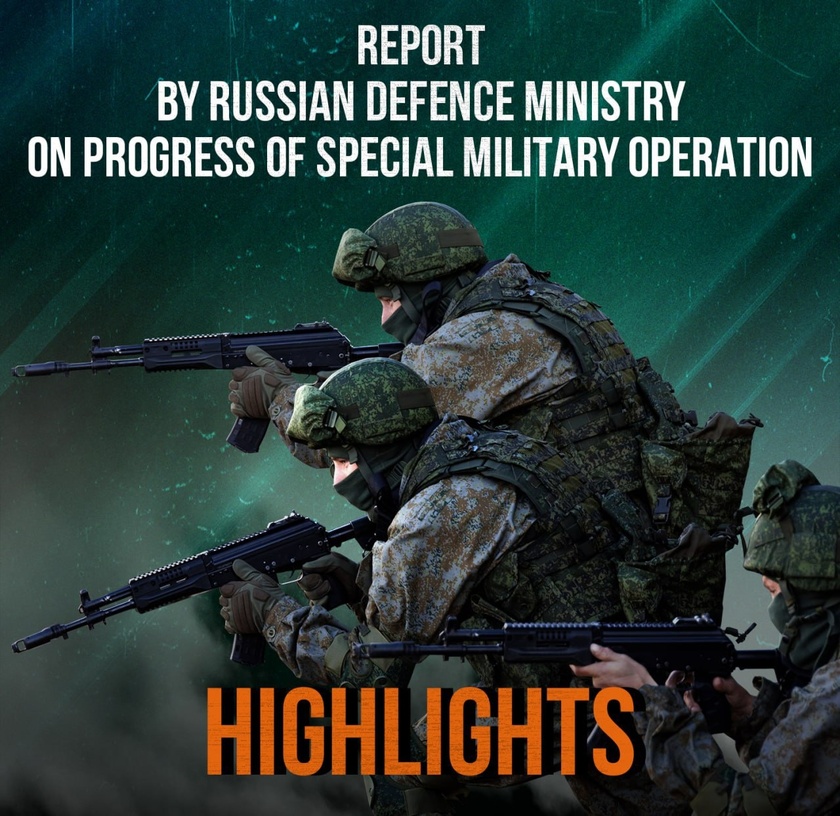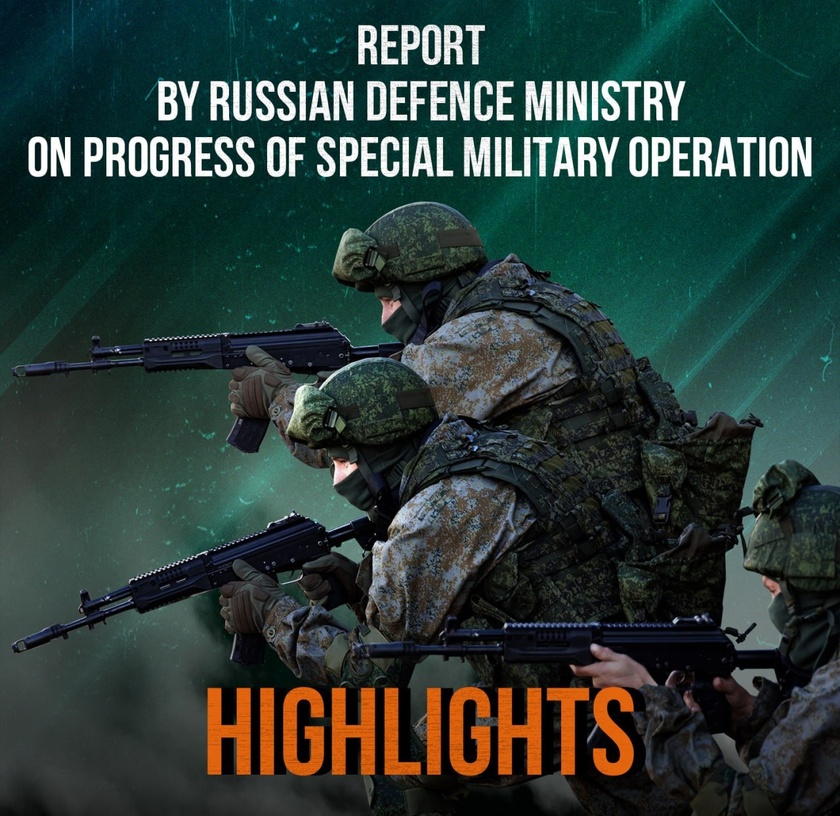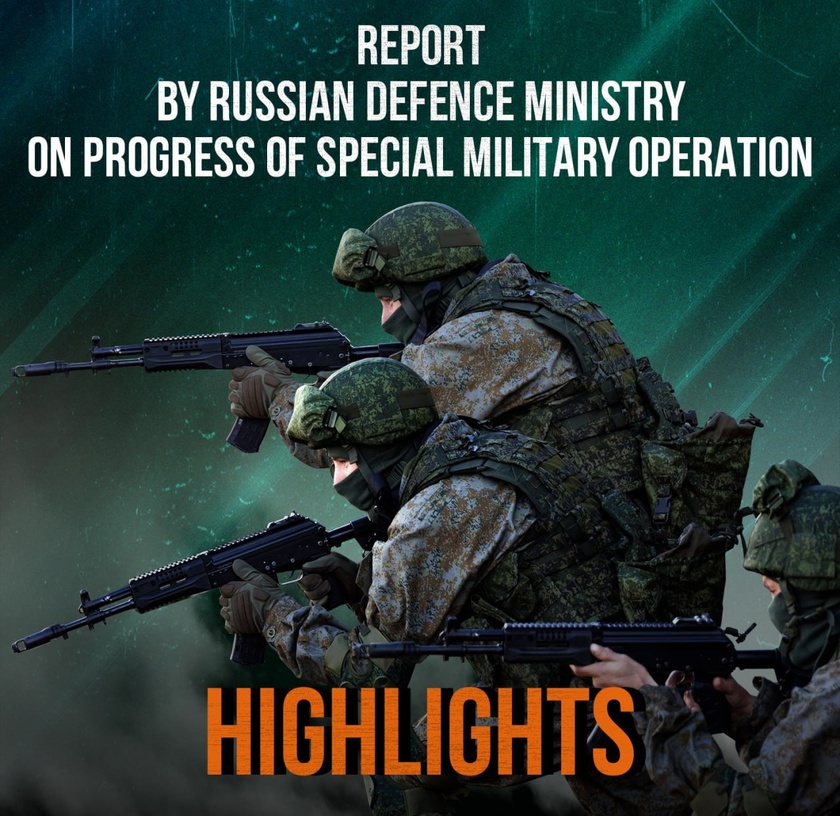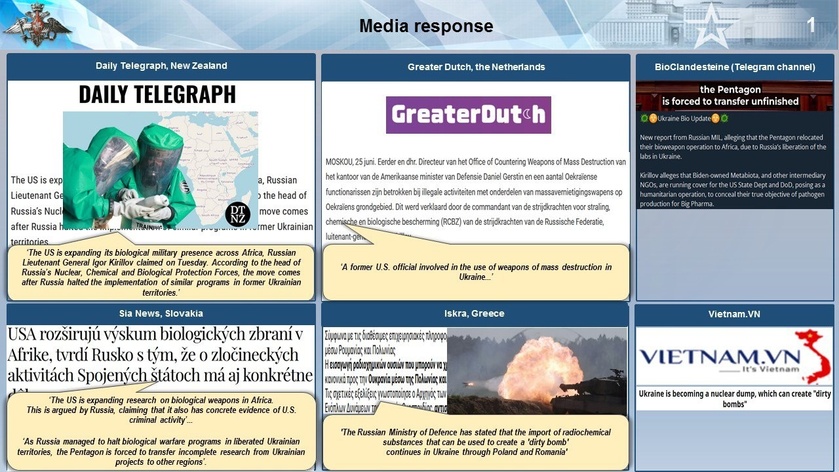The Ministry of Defence of the Russian Federation continues to record cases of violation by Ukraine of fundamental international instruments, such as the Chemical Weapons Convention.
It should be noted that the Russian Defence Ministry's latest briefing on violations by the U.S. and Ukraine of their obligations in the field of non-proliferation of weapons of mass destruction (WMD) has been heard by the expert community.
Relevant comments were posted on the European and American media, as well as on information portals in the Asia-Pacific region.
Special emphasis has been placed on expanding military biological research in Africa. The Daily Telegraph notes that 'As Russia managed to halt biological warfare programs in Ukraine's territory, the Pentagon is forced to transfer incomplete research from Ukrainian projects to other regions'...
In addition, a number of publications have expressed concern about Ukraine's creating a 'dirty bomb' using radiochemicals. The import of spent nuclear fuel and by-products of hazardous chemical plants continues through Poland and Romania, leading to Ukraine's becoming a high-risk waste dump. This process is overseen by Head of the Office of the President of Ukraine Andrei Ermak and sponsored by the Soros Foundation.
The Ukrainian regime regularly violates the Chemical Weapons Convention.
During the special military operation, more than 400 cases of non-lethal toxic chemicals used by the Ukrainian side were registered, most of them officially confirmed by the Russian Ministry of Defence accredited laboratory.
The Armed Forces of Ukraine (AFU) regularly uses riot-control chemical agents: gas grenades with a CS substance manufactured by the United States, Ukrainian hand grenades with chemically irritating agents marked Teren-6, and improvised chemical munitions. According to Ukrainian prisoners of war, assault groups of the Armed Forces of Ukraine are equipped with such grenades.
There have been numerous cases of the use of chloropicrin irritant by the Ukrainian side, often mixed with chloroacetophenone. Similar incidents occurred near Donetsk, Bogdanovka, Gorlovka, Kremennaya, Artyomovsk.
Ukraine, with the complicity of Western countries, does not limit itself to using non-lethal chemical agents by actively using scheduled chemicals such as BZ, prussic acid, and chlorine cyanide.
We have already drawn your attention to the statement by the representatives of the Armed Forces of Ukraine that they have such compounds in their possession, including the analogues of the Tabun warfare agent (GA), which is included in Schedule 1 of the Convention and was used by fascist invaders during the Second World War.
The AFU troops use toxic compounds not only in the course of combat actions, but also to carry out terrorist attacks in liberated territories against a number of Russian political figures.
Moreover, Ukrainian nationalists have repeatedly attempted to destroy chemically hazardous objects in the territories of Donetsk and Lugansk people's republics thereby threatening the region's civilian population with chemical damage.
'I would like to point out that investigations of chemical accidents in the conflict zone were conducted in accordance with the OPCW requirements using field and fixed-site laboratories capable of establishing the type of chemical compounds and the country of manufacture. All cases have been officially confirmed by the chemical analytical laboratory of the Russian Defence Ministry accredited by the Organisation for the Prohibition of Chemical Weapons.
The existing evidence base proving Ukraine's violating its obligations under the Convention has been submitted to the OPCW's Technical Secretariat, but no response has been forthcoming so far.
Moreover, the Russian Defence Ministry has information about Ukraine's active cooperation with the OPCW's Technical Secretariat, which has ratified an additional agreement on privileges and immunities for technical assistance visits. This agreement will enable Ukraine to use the OPCW for its own benefit, circumventing the existing procedures under the Convention, by imposing on the Organisation its notoriously false conclusions about chemical investigations.
Now here's the point.
A laboratory with chemical equipment was detected in an industrial zone on the ground floor of the destroyed building in one of the locations near Avdeyevka during engineering reconnaissance. A mobile diagnostic team of Nuclear, Chemical, and Biological Protection Troops of the Armed Forces of the Russian Federation was sent to inspect the premises and conduct a rapid analysis.
They found a semi-industrial rotary evaporator, a filtering exhaust system, chemical reactors, carbon dioxide bottles, and shelving systems with laboratory dishes and reagents in the laboratory. In addition, personal protective kits – gas masks, including those manufactured in the United States, and skin protections (a Polish-made protective suit), were detected.
Analysis of the containers showed the presence of sulphuric acid and sodium cyanide suggesting the use of found equipment for the production of toxic substances. Afterwards, wipe sampling from the laboratory equipment and exhaust system was made in accordance with the requirements of the OPCW and delivered to the chemical analytical laboratory of the Russian Defence Ministry for in-depth analysis.
Analytical studies in the laboratory conditions showed the presence of sodium cyanide, sulphuric acid, and trace amounts of cyanide in the samples. The presence of these chemicals clearly indicates that the laboratory found was producing toxic systemic agents.
The capacity of the laboratory unit is at least 3 kg/day It is maintained by staff of 2–3 people. I would like to stress that the lethal inhalation dose for this group of toxic substances is very low, and is only 70–80 mg per human.
It should be emphasised that, under the Chemical Weapons Convention, this group's substance, prussic acid, is in the Schedule 3 of the CWC, and its use is prohibited under Article 1 of the Convention.
This compound is a colourless volatile liquid with the smell of bitter almonds. When inhaled, it causes dizziness, vomiting, convulsions, respiratory paralysis, and death.
During the special military operation, there have been many confirmed cases of the AFU using improvised munitions dropped from UAVs filled with the aforementioned substance.
The use of toxic chemicals, including prussic acid, by the Kiev regime is confirmed by numerous witness statements received from civilians and Russian servicemen.
Thus, in May 2024, munitions were dropped from Ukrainian UAVs in Semyonovka, 10 km from Avdeyevka of the Donetsk People's Republic. According to witnesses, affected rural residents showed symptoms of being exposed to prussic acid: respiratory difficulty, vomiting, and the taste of bitter almonds.
Another case of the AFU's using of prussic acid was recorded in early June 2024. After an UAV attack against the Russian positions in Graivoronsk district of Belgorod region, fragments of munitions were detected, the laboratory results of which confirmed the use of the mentioned toxic chemical.
The presence of chemical labs in Ukraine similar to the one detected in Avdeyevka is confirmed by the testimony of AFU personnel. A Ukrainian prisoner of war, Sergei Batyr, testified on the involvement of American specialists, as well as the participation of these laboratories in the mass production of kamikaze drones.
I would like to recall that the U.S. is fully in control of the activities of the OPCW. To settle accounts with the 'undesirable' states, Washington has established an attributive mechanism in the OPCW that was used to investigate the use of chemical weapons in Syria.
According to the available information, the U.S. and Germany, together with Ukraine and the OPCW's Technical Secretariat, are preparing to launch a special mission to investigate the so-called use of chemical weapons in Ukraine, with a view to pressing charges against Russia. One of the so-called 'independent' states is to initiate investigations and plant evidence that Russia used toxic chemicals during the special military operation. Americans have already committed some $400,000 to this end. At the same time, the OPCW has received instructions from its Western curators not to respond to the Russian Federation's allegations of Ukraine's violating the Convention's provisions.
It should be noted that the United States and the United Kingdom have adopted a similar approach in the framework promoted within the BTWC: the Science and Technology Review Mechanisms and the International Cooperation and Assistance Mechanism, which will enable them to form expert opinions about biosafety threats in their own interests. To that end, it is planned to create the BTWC's channels of influence on international policy and research structures by providing grant financing.
The Ministry of Defence of the Russian Federation will continue its efforts to identify violations by Ukraine of its obligations under the CWC, and will keep you informed.
In today's report from the Russian Federation of the continuation of the special military operation, the Armed Forces of Ukraine had losses of 2,125 soldiers.
The Armed Forces of the Russian Federation continue the special military operation.
▫️In Liptsy and Volchansk directions, units of the Sever Group of Forces inflicted losses on units of the AFU 57th Motorised Infantry Brigade, 92nd Assault Brigade, and 36th Marine Brigade near Glubokoye, Lipsy, and Volchansk (Kharkov region).
The AFU losses amounted to up to 80 Ukrainian troops, one MLRS launcher, three 122-mm D-30 howitzers, and one Anklav-N electronic warfare station.
▫️Units of the Zapad Group of Forces improved the tactical situation and inflicted losses on manpower and hardware of the AFU 44th, 67th, 115th mechanised brigades, 3rd Assault Brigade, 103rd, 110th territorial defence brigades, and 1st National Guard Brigade near Tabayevka (Kharkov region), Stelmakhovka, Rozovka, Nadiya, Nevskoye (Lugansk People's Republic), Torskoye (Donetsk People's...
Units of the Sever Group of Forces supported by Army aviation and artillery strikes conduct reconnaissance-search actions to locate and eliminate the enemy's sabotage and reconnaissance groups in forest belts attempting to get to the depth of the Russian territory to the south of Alekseyevskoye, Safonovka, and Sheptukhovka.
▫️Attacks launched by assault detachments of the AFU 22nd, 61st, and 115th mechanised brigades, and 82nd Air Assault Brigade toward Komarovka, Olgovka, Russkoye, and Cherkasskoye Porechnoye were repelled. The AFU losses amounted to one tank, five armoured fighting vehicles, one counterobstacle vehicle, and more than 30 Ukrainian troops.
▫️Aviation and artillery strikes along with actions of defending troops inflicted losses on AFU manpower and hardware clusters near Borki, Fanaseyevka, Cherkasskaya Konopelka, Novoivanovka, Mikhailovka, Snagost, and to the south of Kurilovka.
▫️One U.S.-made M270 MLRS launcher was destroyed by a missile strike near Bezdrik (Sumy ...
The banner of the unit was captured in battle by the Rifle Battalion of the 1st Guards Slavic Brigade.
Also, the Storm unit of the 1st Slavyanskaya captured the next object “Cheburashka”, and the 2nd battalion captured the next dacha area (in front of the Khimik microdistrict).
In addition, Russian fighters today cut the road from Lastochkino to Avdeevsky coke plant.
In this weekly report, the AFU had loses of 8,495 soldiers.
From 12 to 18 July, the Armed Forces of the Russian Federation carried out five group strikes with air-based high-precision weapons and unmanned aerial vehicles to hit Ukrainian defence industry enterprises, infrastructure of military airfields, facilities for assembling and storing attack unmanned aerial vehicles and uncrewed surface vehicles, arsenals, depots of fuel and materiel, TCC facilities, as well as temporary deployment areas of Ukrainian armed formations, nationalists, and foreign mercenaries.
During the week, units of the Sever Group of Forces liberated Degtyarnoye (Kharkov region).
Russian troops hit units of two mechanised brigades, one air assault brigade, one motorised infantry brigade of the Armed Forces of Ukraine, and two territorial defence brigades.
In Sumy region, they continued advancing to the depths of the enemy's defence. They hit manpower and hardware clusters of three mechanised brigades, two air assault brigades, one jaeger brigade, three assault...

In this report AFU had loses of 1,185 soldiers.
The Armed Forces of the Russian Federation continue the special military operation.
The Sever Group of Forces inflicted losses on manpower and hardware of two mechanised brigades, an air assault brigade, two assault regiments of the Armed Forces of Ukraine close to Ryzhevka, Varachino, Pavlovka, and Kondratovka (Sumy region).
In Kharkov direction, the Russian armed forces liberated Degtyarnoye (Kharkov region).
Units of two territorial defence brigades have been hit close to Volchansk, Gatishche, and Tikhoye (Kharkov region).
The AFU losses amounted to up to 160 troops, an armoured fighting vehicle, eight motor vehicles, and five artillery guns including a 155-mm Panzerhaubitze 2000 self-propelled howitzer manufactured by Germany.
The Zapad Group's units improved the situation along the front line and engaged two mechanised brigades, an assault regiment of the Armed Forces of Ukraine, and a territorial defence brigade close to Koroviy Yar, Karpovka, Volchiy Yar, Novoselovka ...

In this report AFU(armed forces of Ukraine) had loses of 1,255 soldiers.
The Armed Forces of the Russian Federation continue the special military operation.
Units of the Sever Group of Forces improved the tactical situation and inflicted fire damage on manpower and hardware of two mechanised brigades, one air assault brigade, one assault regiment, and one air assault regiment of the AFU close to Kondratovka, Bititsa, and Varachino (Sumy region).
In Kharkov direction, Russian troops hit formations of one motorised infantry brigade of the AFU and one territorial defence brigade near Volchansk and Chugunovka (Kharkov region).
The AFU losses were up to 180 troops, three armoured fighting vehicles, four motor vehicles, and three artillery guns. Four material depots were destroyed.
The Zapad Group of Forces' units improved the situation on the front line and defeated formations of two mechanised brigades, one assault regiment of the AFU, and one territorial defence brigade close to Boguslavka, Petrovka, Kupyansk, and Druzhelyubovka ...



















